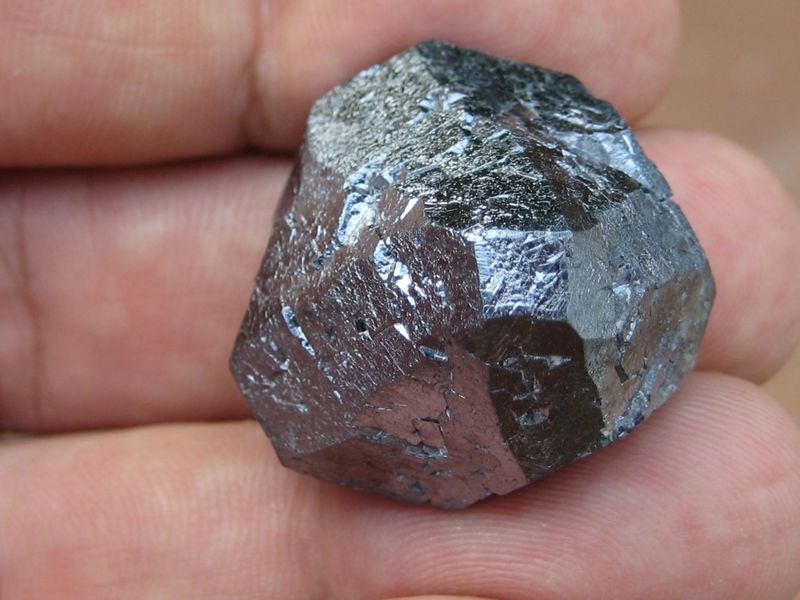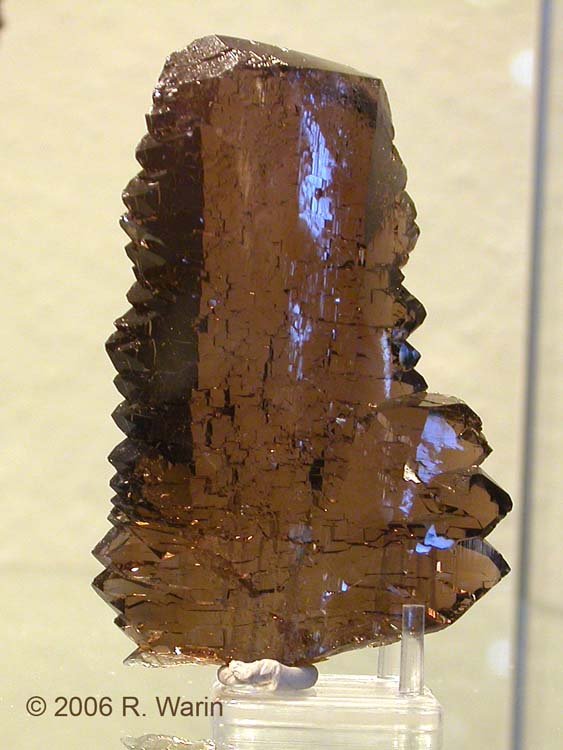| View previous topic :: View next topic |
| Author |
Message |
marco campos-venuti

Joined: 09 Apr 2014
Posts: 240
Location: Sevilla



|
 Posted: Jun 28, 2025 14:11 Post subject: Gwindel Skutterudite? Posted: Jun 28, 2025 14:11 Post subject: Gwindel Skutterudite? |
|
|
A curiosity I found in Sainte Marie this year. This skutterudite crystal from Bou Azzer is twisted. It was a typical Moroccan lot consisting of a box with at least 30 crystals and all of them showed the same phenomenon. And all the crystals were curved in the same direction. I get three of them.
It is difficult to visualize in a single photo. To clarify for the observer, the square faces are of the cube (6), the triangular ones are of the octahedron (8) and the elongated ones are of the rhombohedron (12). The photo is centered on one face of the cube and we can see that the rhombohedron face at the top bends to the left. I measured a rotation of 28 degrees, measured between the cube face and the rotated rhombohedron face which in an ideal crystal should be parallel to the cube.
Has anyone ever seen this phenomenon? Can we talk of Gwindel Skutterudite?
| Mineral: | Skutterudite |
| Locality: | | Bou Azzer mining district, Drâa-Tafilalet Region, Morocco |  |
|
| Dimensions: | 3 cm |
| Description: |
|
| Viewed: |
1595 Time(s) |

|
|
|
| Back to top |
|
 |
Roger Warin

Joined: 23 Jan 2013
Posts: 1251



|
 Posted: Jun 29, 2025 00:14 Post subject: Re: Gwindel Skutterudite? Posted: Jun 29, 2025 00:14 Post subject: Re: Gwindel Skutterudite? |
|
|
Hello Marco,
I won't mention a possibility similar to the formation of twisted quartz, because only quartz, with its unique tectosilicate structure, can cause such deviations. I think Pete is much more knowledgeable than I am and can give you better advice.
As you know, for other reasons, silica is my nemesis.
Actually, it's been a long time since we've talked about Gwindels on FMF.
I'd like to see the subject brought up again on the forum.
Your skutterudite crystal has undergone somewhat chaotic growth, which I would attribute to poorly stabilized growth kinetics. The important thing is that the lattice appears intact. The proof is that there is only one multiple axis in the photo. It is a single crystal whose lattice appears perfect but whose overall morphology has been affected by the vagaries of growth.
The environment must have been disturbed, but the influence of the lattice remained predominant for thermodynamic reasons.
You know the problems posed by Dauphiné twinning, which occurs without significant displacement of atoms. Even des Cloizeaux (1817-1897) mentioned it.
A Gwindel results from parallel-axis growth undergoing a slight (random) deviation from the vertical axis. The chirality of quartz remains.
I have attached a very long, exceptional Gwindel as an illustration.
| Mineral: | Quartz |
| Description: |
|
| Viewed: |
1535 Time(s) |

|
|
|
| Back to top |
|
 |
Pete Richards
Site Admin

Joined: 29 Dec 2008
Posts: 846
Location: Northeast Ohio



|
 Posted: Jun 29, 2025 13:59 Post subject: Re: Gwindel Skutterudite? Posted: Jun 29, 2025 13:59 Post subject: Re: Gwindel Skutterudite? |
|
|
This is a very interesting, obviously twisted crystal. I have never seen one like it. Perhaps you should have purchased all 30 of them!
My own opinion (since Roger asked) is that this should not be called a gwindel. This term refers very specifically to a twisted quartz crystal, and indeed to a specific kind of twisting (and elongation), occurring around an a-axis. Even quartz that is twisted around its c-axis is not called a gwindel, as far as I am aware.
Many mineral species have twisted crystals, heulandite and neptunite being familiar examples. Other species have split crystals, which are more broadly distorted, including some typically botryoidal species like prehnite and adamite.
To extend the term gwindel to even some of these would be to lose most of the meaning of the term, without any gain. It is best just to call these twisted crystals.
_________________
Collecting and studying crystals with interesting habits, twinning, and epitaxy |
|
| Back to top |
|
 |
marco campos-venuti

Joined: 09 Apr 2014
Posts: 240
Location: Sevilla



|
 Posted: Jun 30, 2025 12:07 Post subject: Re: Gwindel Skutterudite? Posted: Jun 30, 2025 12:07 Post subject: Re: Gwindel Skutterudite? |
|
|
Dear Roger and Pete, thank you for your comments. The title of the post was intentionally provocative. However, I would like to open the controversy.
Mindat clearly says that "any gwindel is necessarily a quartz". The same could be said of Faden quartz until a few years ago. Today many different minerals are known to form Faden and I am preparing a book on the subject.
In the world of crystals there are many types of distorted or bent crystals, and crystals with curved faces. However, there is only one known example of a twisted chiral crystal, the Gwindel quartz. We cannot infer chirality in bent or distorted crystals, so only Gwindels are chiral. Despite the efforts of scholars we still do not know how and why they form, although we suspect that the presence of abundant screw dislocations and the geometry of the silica molecule are somehow responsible.
Crystallography is an exact science and full of descriptive terms. In the long repertoire of crystallographic terms there is only one word to indicate a chiral crystal, the term Gwindel. So I have to assume that the term Gwindel refers to a crystalline phenomenon and not to a variety of quartz. So if Faden of other minerals besides quartz have been found, why should we rule out the possibility of finding other minerals with a Gwindel structure?
Although more detailed observations will be needed to confirm the chirality of these skutterudite crystals, if the chirality is confirmed, I believe we could truly call these crystals Gwindel skutterudite.
|
|
| Back to top |
|
 |
|





